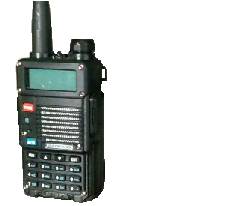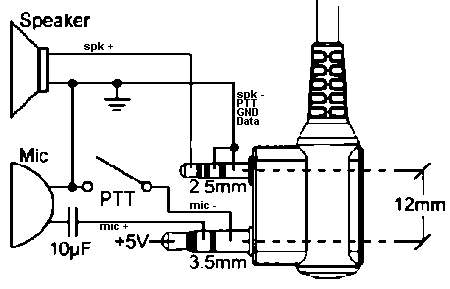Baofeng BF-F8HP
The Pofung / Baofeng BF-F8HP is a newer high power version of the Baofeng UV-5R. Many of the operations of the UV-5R will be identical or close to those of the F8HP.
|
Baofeng BF-F8HP
|
Contents
review
![]() This is a high output little HT with extended VHF and UHF coverage. Many newly licensed hams choose the UV-5R family of HTs for repeater use. The F8HP is basically a UV-5R on steroids.
This is a high output little HT with extended VHF and UHF coverage. Many newly licensed hams choose the UV-5R family of HTs for repeater use. The F8HP is basically a UV-5R on steroids.
In my testing I found the BF-F8HP I used was off frequency according to a calibrated frequency counter. Although within tolerances, it was marginal.
It does not put out a true 8 watts, as typical for Chinese hype it is somewhat less, about 6.5 watts on VHF full power. It definitely has more output than the UV-5R.
The HT is easy to program from the front or using software. I recommend using CHIRP if programming from a PC as CHIRP is much better than the supplied Chinese programming software.
The shape of the BF-F8HP is horrible. It has four tiny feet that are inset so that there is reduced stability. It is constantly falling over when the table is bumped. I finally ground the feet off even with the base so that it would stand up better on the table.
In conclusion, if you can purchase the F8HP for under $50 then you will find it an acceptable HT for repeater work. Hopefully the Chinese introduce an improved model with the same output power, better frequency tolerances, and a more sensible exterior shape as to make it stable when standing upright.
Operation
program channel into memory
- While in FREQUENCY mode enter the channel frequency.
- Press MENU+2+7
- Press MENU and select the desired channel with arrow buttons
- Press MENU to confirm channel selection
- Press EXIT
NOTE: A new out of the box radio has some channels pre-programmed in. Changing channels 1-6 was not working until each channel was deleted from the menu. Delete is function MENU+2+8.
dual monitor
TDR (Dual Watch/Dual RX)
This radio is a dual watch radio with one receiver that can flip between two frequencies as opposed to higher end radios having dual VFO which would require two receivers.
The dual watch function can be enabled
- Press MENU+7 (TDR)
- Press MENU and select
- arrow up and down to toggle dual watch ON/OFF
- Press MENU to confirm
- Press EXIT
FM broadcast radio
Like some of the other Baofeng models, this unit has a good quality extended FM broadcast band receiver. It covers 65Mhz - 108Mhz.
- Press CALL button to activate the FM radio; press again to deactivate. Press the *SCAN button to scan the FM channels.
- Toggle 65Mhz / 88Mhz by pressing the A/B button
When a two-way transmission is detected, the FM broadcast radio cuts out so the incoming communication has priority. One caveat though, you cannot Dual Watch the two transceiver frequencies. It will only monitor one of the two while in FM broadcast listening. It will monitor the last one which was active. So if you had watch monitor (A) active monitoring a UHF Ham frequency while listening to FM Broadcast, even with TDR set to ON, monitor (B) will not be watched.
You can’t store FM channels in the radio’s memories, but you can use the scan function to jump from one radio station to the next.
Undocumented functions
Although this radio has a battery level indicator in the upper right of the LCD, you can press and hold the 0 (zero) button while the unit is powered on to get a brief battery voltage reading.
Accessory
The accessory jack on the Baofeng UV-5R is a Kenwood compatible two(2)-pin design. Many imported radios use Kenwood compatible 2-pin connector including Baofeng and Wouxun. There are a number of similar two pin connectors that may look identical but are not compatible.
Antenna
The antenna is an SMA RF connector. The stock antenna is high performance and works better than most replacement antennas. The radio has an inset SMA Male connector and the antenna is SMA female.
If using in a vehicle you should consider using an external antenna that mounts on the vehicle.
Computer Connection
You can use the Pofung software or you can use an aftermarket software called CHIRP.
When connecting the USB serial cable Windows XP begins "New Hardware Wizard." Allow it to automatically detect and install the driver. It will detect and install "Prolific USB-to-Serial Comm Port." Do this with the Baofeng radio turned on.
Now that a driver is installed you are ready to use either the factory software or the alternative CHIRP software to interface and program your radio.
Everything you need to download, and use either CHIRP or the Baofeng OEM software:
Technical Support
Firmware Update
The firmware in these radios cannot be updated. The microcontroller is an OTP type. (One Time Programmable) Once 'flash' programmed at the factory, it cannot be changed.
Birdies
These radios use a 26MHz reference oscillator. These have been known to cause interference on the following frequencies which are multiples of 26. -> 156.0, 234.0, 416.0, 442.0, 468.0, 494.0 MHz.
Can only program empty channels
This is correct. If you wish to change the channel program you must first delete, then reenter, unless you are using PC software.
Manual programming of memory channels can Only be done while display A (top display) is selected.
select channels to skip when scanning
Selecting channels to be skipped during the scanning process can only be done via software. This cannot be done using the keyp
Hacking for Out of Band Frequencies
There is a lot of bunk information on this topic. Yes, you can enter frequencies that are out of the factory range using software. No, most of these will not work. It will display the frequency but it will not actually transmit or receive, most of the time.
VHF range 136-174 MHz expands to 128-176 MHz UHF range 400-520 MHz expands to 384-524 MHz
Outside of the above range, the radio would either not transmit or was unstable. Receiver coverage drops off sharply to zero outside the factory specified range. Reference: Opening Up: the Frequency Range
Just being able to upload a given frequency to the radio and get it to show up on the display does not qualify it as being "unlocked."

